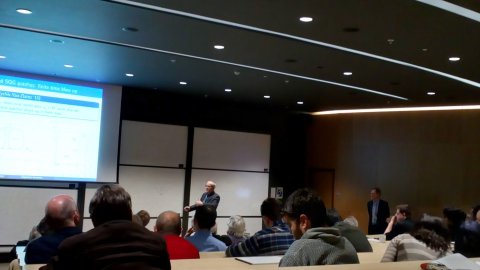Enhancing Wind Energy Using Unsteady Fluid Mechanics
For more information, please visit: The Brooke Benjamin Lecture in Fluid Mechanics | Mathematical Institute
Abstract
This talk will describe recent studies of how time-dependent, unsteady flow physics can be exploited to improve the performance of energy harvesting systems such as wind turbines. A theoretical analysis will revisit the seminal Betz derivation to identify the role of unsteady flow from first principles. Following will be a discussion of an experimental campaign to test the predictions of the theoretical model. Finally, a new line of research related to turbulence transition and inspired by the work of T. Brooke Benjamin will be introduced.
Letting AI untie the Knots
Abstract
Our main tool for this purpose are the topological invariants associated to a knot. However, computing them is not in general an easy task: it boils down to make a sequence of choices, a rather difficult work for us human. This is why, in recent years, mathematicians have begun using AI-driven solutions to compute these invariants, hoping that machines can identify patterns within the apparent chaos of possibilities.
In this talk, we are going to see how to compute two fundamental invariants, namely Unknotting Number and Slice Genus, with the aid of a Reinforcement Learning (RL) agent. We will start with the basic definitions from Knot Theory and Deep Learning, focusing on concepts rather than technical details, with the ultimate goal of understanding what RL is and how we can exploit it.
We invite applications for a Postdoctoral Research Associate (PDRA) to join the EPSRC Hub on the Mathematical and Computational Foundations of Artificial Intelligence. One PDRA will be recruited to work within one of, or across, the four research themes: Learning with Structured & Geometric Models, Low Effective-dimensional Learning Models, Implicit Regularization, and Reinforcement Learning through Stochastic Control (a brief description of each these is as follows (additional details are in the further particulars):
Flowing to Free Boundary Minimal Surfaces
Abstract
In this talk, I will discuss an approach to free boundary minimal surfaces which comes out of recent work by Struwe on a non-local energy, called the half-energy. I will introduce the gradient flow of this functional and its theory in the already studied case of disc type domains, covering existence, uniqueness, regularity and singularity analysis and highlighting the striking parallels with the theory of the classical harmonic map flow. Then I will go on to present new work, joint with Melanie Rupflin and Michael Struwe, which extends this theory to all compact surfaces with boundary. This relies upon combining the above ideas with those of the Teichmüller harmonic map flow introduced by Rupflin and Topping.



